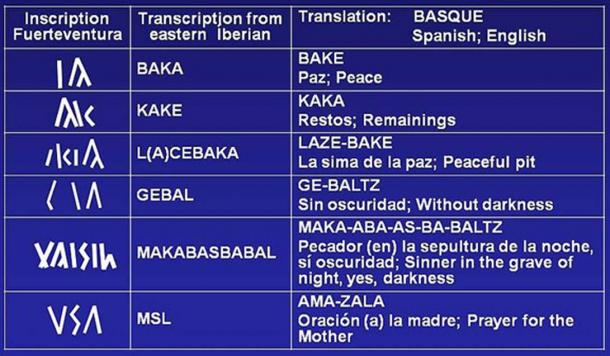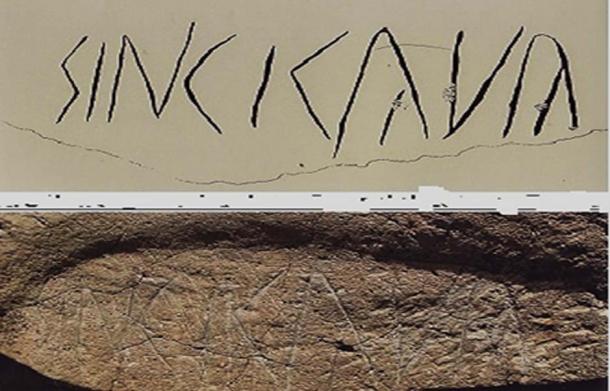
Did Celts Create the IBERO-GUANCHE Writing of the Canary Islands?
The origins of the first Canary Islanders is a mystery. When the Roman author and military officer Pliny the Elder wrote of an expedition to the islands he mentioned ruins of grand buildings, but nothing of the islands’ inhabitants. Perhaps inscriptions left by the ancient locals will tell something of their story?
Before beginning this article, it is important to remember: The Canary Islands are in the Atlantic Ocean off the coast of West Africa. It is also important to note that the Guanches are a mysterious people who were sold into slavery and/or absorbed by the Spanish.
Antonio Arnaiz-Villena of the University Complutense’s School of Medicine in Madrid, Spain believes that the ancient Iberians were Celts. Using Herodotus’ ‘Histories’, Dr. Arnaiz-Villena argues that the Celts (Keltoi) originated in Iberia; and the city of Pyrene in the country of Celts (Keltoi) mentioned by Herodutus was the Pyrenees Mountains, which he quoted as “the city of Pyrene”. This suggests that the Guanches may be descendants of the Celts.
- The Mystery of the Guanches and the Pyramids of Tenerife
- A Unique Form of Ancient Communication: The Whistling Island of La Gomera
- Mysterious GodSelf Icon Found Worldwide: Lost Symbol of an Ancient Global Religion?

Representation of Celts. (The West’s Darkest Hour)
Who Were the First Canary Islanders?
Numerous inscriptions have been found in the Canary Islands. These inscriptions have been found on the Islands of Lanzarote and Fuerteventura. They may have been written by the Guanches, the original inhabitants of the Canary Islands. The writing system is called IBERO-GUANCHE.

Examples and possible translations of Iberian-Guanche inscriptions from Fuerteventura. (Iberomesornix/CC BY 3.0)
The origin of the Canary Islanders is a mystery. Some people believe the Guanches may have migrated from North Africa and the Sahara and moved onto the Canary Islands and into Iberia as the Sahara became arid.
Arnaiz-Villena and Alonso-Garcia believe that fishermen from Cadiz, a Spanish city situated near the Gibraltar Strait, may have left the inscriptions on Lanzarote and Fuerteventura. They base this conclusion on two points: Plutarch, and fishing near the Islands of Lanzarote and Fuerteventura.

Guanches on Tenerife. (R. Liebau/CC BY SA 3.0)
In his book ‘ Parallel Lives’, the Philosopher Plutarch discussed the Roman-Iberian commander Sertorius’ report that two fishermen of Cadiz noted that abundant fishing could be found on islands near Africa. Researchers believe that Iberians may have been talking about Lanzarote and Fuerteventura, the birth zone for tuna fish, which was a major item in the Cadiz fishing industry.
Understanding the Inscriptions
In 1980, 280 inscriptions were found on the islands of Fuerteventura and Lanzarote. Most of these inscriptions were found on Fuerteventura.
Researchers claim the Canary Inscriptions are “Latin Inscriptions” and “Libyco-Berber Inscriptions”. As a result, they hypothesize the inscriptions were probably written in the Iberian (and Libyco-Berber) language. These inscriptions are often associated with pyramids on the Canary Islands (according to Arnaiz-Villena.)

Lanzarote Iberian inscription. (Author provided)
The Iberian language is classified as Basque. It is a member of the Usko-Mediterranean language Superfamily, and is included among the Dene Caucasian language family.
The Iberian script dates to 800 BC. Iberian inscriptions were written up to 300 AD, and were used in Sardinia, Iberia, and Southern France. Some researchers believe the inscriptions were written by Iberian fishermen, but researchers such as Arnaiz-Villena believe that Africans had also migrated to the Canary Islands because the Iberian texts are often found beside Libyco-Berber inscriptions.
- Floating Islands Seen at Sea: Myth and Reality
- World’s Oldest Slave Cemetery May Have Been Found
- Ancient Cave in Spain reveals advanced astronomical knowledge of inhabitants

Prehistoric rock art, Libyco-berber inscriptions: Foum Chena/ Tinzouline - Zagora, valley of the River Draa, Morocco. (Public Domain)
Arnaiz-Villena and Alonso García have identified the Guanche inscriptions as Latin inscriptions. They have translated the inscriptions based on the Usko-Mediterranean languages. The translation of the Guanche Inscriptions show that they were funerary inscriptions or had a religious theme. They call this writing IBERO-GUANCHE writing.
In summary, the Canary Island inscriptions were probably written by Iberians and North Africans. As a result, the Guanche inscriptions are not found in isolation. The IBERO-GUANCHE inscriptions are usually engraved on rocks or in caves associated with the ancient Libyco-Berber inscriptions. Moreover, the Canary Island pyramids resemble Tenerife Island pyramids discovered by Thor Heyerdhal.

Pyramids of Güímar, Tenerife. (Public Domain)
Top image: Statue of "El Gran Tinerfe" in Adeje, Tenerife. Source: Frank C. Müller/CC BY SA 2.5
References
Antonio Arnaiz-Villena et al. HLA genes in Atlantic Celtic populations: Are Celts Iberians? International Journal of Modern Anthropology, Journal Home > Vol 1, No 10 (2017).
Available at: https://www.ajol.info/index.php/ijma/article/view/155563
Antonio Arnaiz-Villena, et al (2015). Origin of Ancient Canary Islanders (Guanches): Presence of Atlantic/Iberian HLA and Y chromosome genes and Ancient Iberian language. International Journal of Modern Anthropology, 8:67-93.
Antonio Arnáiz-Villena and Javier Alonso-Rubio, LAS ESCRITURAS IBERO-GUANCHES DE LANZAROTE Y FUERTEVENTURA: Cornisa atlánico-europea y los celtas/íberos.
Available at: http://basques-iberians.blogspot.com.es/2014/02/la-ruta-delatun-explicaria-las.html ; http://basques-iberians.blogspot.com.es/2013/11/las-escriturasibero-guanches-de.html
Arnaiz-Villena A y Alonso García J. Egipcios, Bereberes, Guanches y Vascos (2ª edición). Fundación Estudios Genéticos y Lingüísticos – Complutense. Nueva Edición 2011. Ed Visión Libros. Madrid, España. 2000. Aquí















